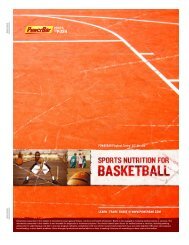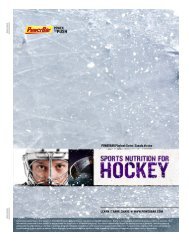PowerBar Playbook Series | Canadian Version - PowerBar.Com
PowerBar Playbook Series | Canadian Version - PowerBar.Com
PowerBar Playbook Series | Canadian Version - PowerBar.Com
Create successful ePaper yourself
Turn your PDF publications into a flip-book with our unique Google optimized e-Paper software.
<strong>PowerBar</strong> <strong>Playbook</strong> <strong>Series</strong> | Sports Nutrition For Triathlon<br />
<strong>PowerBar</strong> athlete<br />
TIM hola<br />
and back-to-back workouts can literally wipe out these carbohydrate<br />
fuel reserves. When that happens, you “bonk,” or “hit the wall,” and have<br />
no choice but to drastically slow your pace or even stop. Therefore, it’s<br />
critical that you start your training and racing with carbohydrate fuel<br />
reserves fully replenished, and that you refuel during exercise in order<br />
to provide you with energy needed and help you prepare for<br />
high-endurance activities.<br />
RECOVERY 10<br />
Recovery is the post-exercise process of reloading depleted<br />
carbohydrate fuel stores, repairing muscle tissue damaged during<br />
exercise, building new muscle tissue in response to training, and<br />
rehydrating with fluids and sodium. It’s during the recovery process<br />
that you achieve the gains from training and get ready for your next<br />
workout or race. Your body is ready to begin recovery the minute<br />
that you finish working out or racing, but the process only starts<br />
when you provide the key nutritional components.<br />
PHOTO BY: larry rosa<br />
<strong>PowerBar</strong> athlete<br />
BELINDA GRANGER<br />
PRACTICAL SPORTS NUTRITION STRATEGIES<br />
FOR TRIATHLON<br />
Fortunately, there are easy-to-implement sports nutrition strategies<br />
that can help you prepare for and remain strong when training and<br />
racing. They can also help ensure that you fully recover after exercise<br />
so that you’re ready for whatever comes next.<br />
BE WEIGHT SMART<br />
If you are an elite triathlete in the throes of heavy training, getting<br />
enough calories and carbohydrates on a daily basis can be a challenge.<br />
Small and frequent meals, snacks between workouts, and eating while<br />
training on the bike are often necessary in order to meet your needs<br />
for calories and carbs. Carry a cooler to your training venue, and pack<br />
it with sandwiches, bagels, fruit, and a recovery beverage. And make<br />
sure that your workout bag, backpack, or briefcase has an assortment<br />
of energy/protein bars, gels, bites, and chews.<br />
If you are more of a recreational triathlete, be sure to balance your<br />
intake of gels, bars, and sports drinks with your carbohydrate and<br />
calorie needs so that you achieve and maintain a desirable weight.<br />
PHOTO BY: LARRY ROSA<br />
If you are new to the sport or just coming back after a layoff, there<br />
might be a need to trim excess body fat. Don’t try to accomplish this<br />
feat during periods of heavy training. It can result in loss of muscle<br />
mass, slower recovery, and an increased chance of illness and injury.<br />
And for women it can also result in hormonal imbalances leading to<br />
menstrual dysfunction and permanent loss of bone mass and strength.<br />
Instead, make weight loss a goal of the off-season or early season,<br />
before training gets too intense. To cut calories, trim your consumption<br />
For more information and additional copies, go to: www.powerbar.com/playbooks<br />
<strong>PowerBar</strong> ® , <strong>PowerBar</strong> ProteinPlus ® , Bites, C2MAX, Energy Bites, Fruit Energize, Gel Blasts, Harvest Energy, NutritionCoach, Power to Push,<br />
PowerCoach, Sport Energy, Triple Threat Energy, and TriSource are trademarks and registered trademarks owned by Société des Produits Nestlé S.A.,<br />
Vevey, Switzerland.<br />
5







